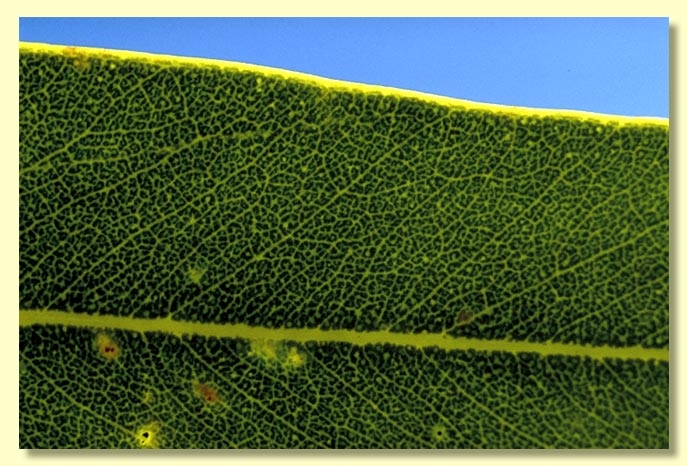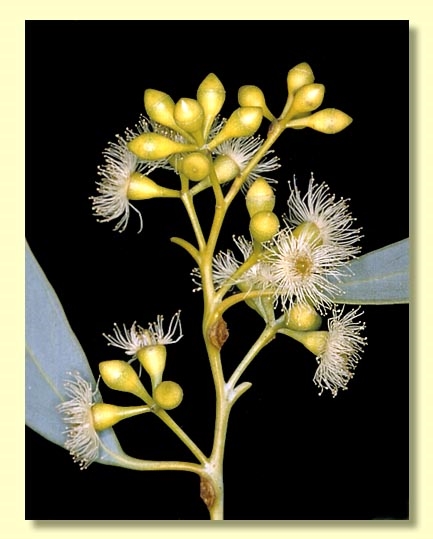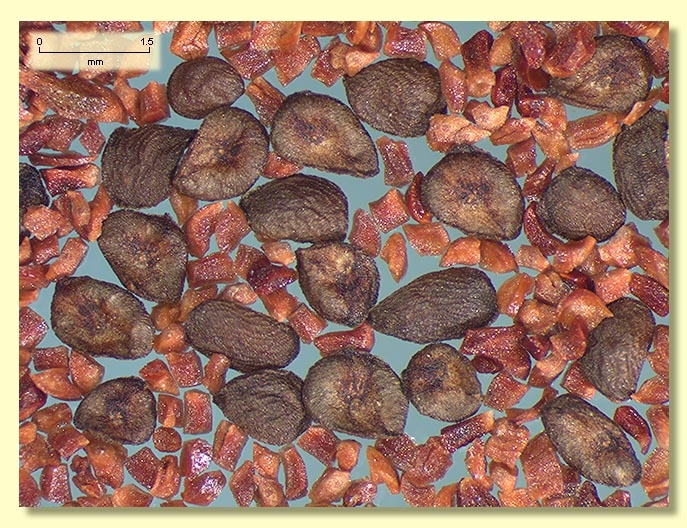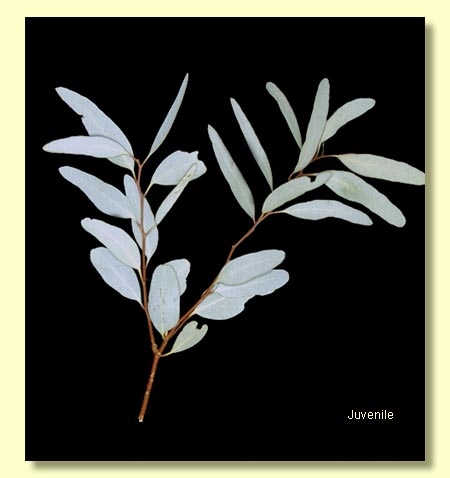Euclid - Online edition
Eucalyptus intertexta
Eucalyptus | Symphyomyrtus | Adnataria | Apicales | Buxeales | Amissae
T: New South Wales: Nyngan, W. Baeuerlen s.n., November 1899; Lectotype: (NSW330009); fide Bean, A.R., Telopea 12(4): 471-472 (2010).
E. intertexta var. fruticosa Blakely & Jacobs in W.F.Blakely, Key Eucalypts 168 (1934). T: White Range Goldfield, N.T., Aug. 1933, M.R.Jacobs 178; syn: NSW; White Ra creek beds, N.T., Aug. 1933, M.R.Jacobs 179; syn: BRI, NSW.
E. intertexta var. diminuta Blakely, Key Eucalypts 169 (1934). T: Mt Cooper, Cavanagh Ra., W.A., 31 July 1891, R.Helms s.n.; holo: NSW.
Bark rough on lower trunk, rarely over whole trunk, thick, fibrous, often box-type, grey to red-brown; smooth above, predominantly white with grey or brown patches shedding in flakes; Branchlets sometimes glaucous; lacking oil glands in the pith.
Juvenile growth (coppice or field seedlings to 50 cm): stems round or square in cross-section, usually smooth, sometimes glaucous; juvenile leaves always petiolate, opposite for 2 to 7 pairs then alternate, lanceolate, 3–12 cm long, 1–3.5 cm wide, base tapering, dull, grey-green to blue-green or glaucous.
Adult leaves alternate, petiole 0.5–1.5 cm long; blade lanceolate, 5–16 cm long, 0.8–2.5 cm wide, base tapering to petiole, concolorous, dull, blue-green or grey-green or subglaucous, side-veins at an acute or wider angle to midrib, densely reticulate, intramarginal vein parallel to and just within margin or remote from it (occasionally absent), oil glands intersectional or obscure.
Inflorescence terminal compound, or sometimes with a few axillary umbels also, peduncles 0.5–1.7 cm long, buds 7 per umbel, pedicels 0.2–0.8 cm long. Mature buds obovoid to ovoid, 0.4–0.8 cm long, 0.2–0.4 cm wide, green or sometimes glaucous, hypanthium with faint ribs continued from angular pedicel, scar present (outer operculum lost early in bud development), operculum conical, stamens inflexed or irregularly flexed, anthers subversatile or adnate, basifixed, cuboid, dehiscing by longitudinal slits, style long, stigma blunt, ovary chambers 4 or 5 each with 4 vertical ovule rows; flowers white.
Fruit pedicellate (pedicels 0.1–0.8 cm long), cupular to hemispherical, 0.3–0.9 cm long, 0.4–0.8 cm wide, sometimes slightly ribbed longitudinally, disc descending, valves 4 or 5, enclosed.
Seeds brown, 1–1.7 mm long, ovoid or flattened-ovoid, dorsal surface pitted, hilum ventral.
Cultivated seedlings (measured at node 10): cotyledons reniform; stems square in cross-section, glaucous or non-glaucous, maybe slightly warty; leaves always petiolate, opposite for 4 to 7 nodes then alternate, ovate-lanceolate, 3.5–10 cm long, 1.5–3 cm wide, dull, bluish green or slightly glaucous.
Flowering has been recorded in all months except January.
A tree, rarely a mallee, widespread in arid and semi-arid Australia, from north of the Murray River in South Australia, extending east through central New South Wales as far as Nyngan and south to Euston, north into Queensland in the St George to Dirranbandi region and growing in a large area of central Australia, particularly the far north of South Australia, including the Northern Flinders Ranges, and the southern Northern Territory extending to the Giles–Warburton area of Western Australia. It is distinguished by the straggly tree form, smooth upper trunk and branches, dull adult leaves, buds with an operculum scar and lanceolate juvenile leaves
In Queensland it could be confused with the closely related species E. orgadophila. E. intertexta differs marginally by having slightly smaller fruit 0.4–0.8 cm wide(0.6–1 cm wide for E. orgadophila) and lanceolate juvenile leaves (3)4.5-12 cm long (juvenile leaves usually ovate and 3-6 cm long in E. orgadophila).
E. intertexta does not grow on the heavy clay soil floodplains where E. microtheca (northern Australia only), E. coolabah and E. largiflorens are the common box species. E. intertexta can be further separated from E. coolabah by having larger fruit with enclosed valves (strongly exserted in E. coolabah). E. largiflorens has rough bark extending to small branches. Between Giles and Warburton E. intertexta grows as a creek gum where River Red Gum (E. camaldulensis subsp. arida) might have been expected.
Eucalyptus intertexta belongs in Eucalyptus subgenus Symphyomyrtus section Adnataria (the boxes) because the buds have two opercula, ovules are in four rows, seeds are flattened-ovoid, cotyledons are reniform, and anthers are rigid on the staminal filaments. Within section Adnataria, E. intertexta is in a subgroup, series Buxeales, further distinguished by terminal inflorescences, buds with an operculum scar (outer operculum shed early), all stamens being fertile, and by dull, not glossy adult leaves.















